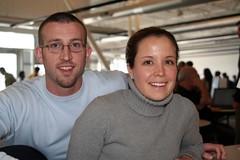I couldn’t attend Day 1 of Mashup Camp (at which Lawrence Lessig spoke), because I was out of town, but Day 2 was a doozy. Here are 5 photos I took today.
Mashup Camp could well have been named Web 2.0 Camp — it was a celebration and display of some of the astounding new startups and applications that are redefining what the Internet is all about. It’s becoming a place where users take charge of data, using tools that let us slice and dice information in useful and interesting ways.
Among the people I spotted or chatted up in the crowd of 300 (it’s late, so don’t expect links): Doc Searls, Mary Hodder, Dave Winer, David Berlind, Doug Gold, Tantek Celik, Robin Sloan, Marc Canter, Peter Kaminski, Adrian Holovaty, Mike Rowehl, Steve Gillmor, Dan Farber, Dan Gillmor, and many others. Alas, women were woefully underrepresented (not the organizers’ fault): In two sessions I attended, the count was 45 men to 3 women, and 15 men to zero women.
Every demo I caught during the “speed geeking” session was fascinating. Some links to check out:
• Mozes, which connects you to information on the move through your mobile device.
• Ning, which offers a slew of free cool developer tools. Check out these screencasts.
• TagCloud, a folksonomy tool that lets you find stuff through tagging.
• Podbop, which not only alerts you to upcoming events, such as concerts, but also scours the Web for free legal mp3s of bands you find articles associated with keywords, among other things.
• Flyspy, a site still in alpha that will let you find the cheapest airline flights at different times of the day, among other things. I’ll be using it a lot when it debuts in a few months.
• ChicagoCrime, which I’ve lauded months ago. By mashing up Google Maps with Chicago Police Department maps, Adrian Holovaty has created a first-class community resource that other communities would do well to emulate. You can even subscribe to an RSS feed of crime news from your surrounding neighborhood — very cool, very useful.
Bonus link:
blogs.washingtonpost.com/post_remix, which lets the audience post mashups of interest to the Post’s audience.
For more, see the mashupcamp tag on Technorati and on Flickr.
Tags: Mashup Camp, mashups, Web 2.0, citizen journalism
JD Lasica, founder of Inside Social Media, is also a fiction author and the co-founder of the cruise discovery engine Cruiseable. See his About page, contact JD or follow him on Twitter.

i like social/web 2.0 sites, but when looking closer at them, there is often something that makes me think twice… i tested tag cloud a couple of month ago and while i liked the look a lot, there was one big dis-ad-vantage: ads. somehow everything was filtered/mixed with yahoo ads. so if just one user tagged a site that had a lot of presence in the yahoo ad system, then you would get a huge tag, making you think that this tag has a lot of significance – money/advertising can easily diminish the usefulness of a great web 2.0 idea…
Just curious JD: how do you *define* whether or not women being underrepresented is or is not an organizer’s fault? Not saying it was, just wondering why you state that it wasn’t so confidently. Thanks.
In this case, because I know the organizers, and because they put out an open call on the Web for participants, and because Mary Hodder (whose company employs a developer workforce that is 50% women) was one of the two principals in charge of the demos.
You’ll have to ask women who thought about going why they wound up not attending. Perhaps a geekfest is a turnoff for some reason.